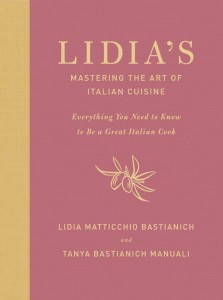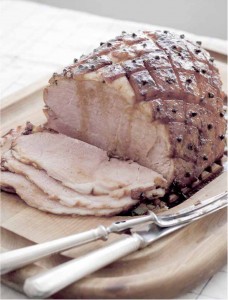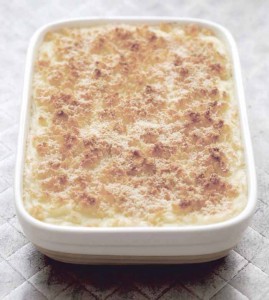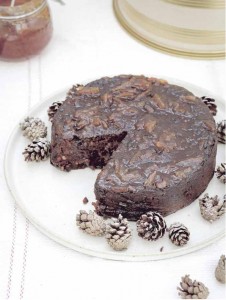If you’re looking for an impressive Christmas spread or tasty snack ideas between meals, culinary stars Lidia Matticchio Bastianich and Nigella Lawson both have new books that will help you put your best dishes forward during the holiday season.
Lidia’s Mastering the Art of Italian Cuisine is a must-have for lovers of Italian food and for those looking for a challenge in the kitchen.
A basic guide to Italian food that takes you from newbie to knowledgeable, Bastianich and daughter Tanya Bastianich Manuali provide section after section on the produce of Italy, cheeses, fresh pasta, meats, kitchen tools and cooking techniques.
Featuring many recipes from Bastianich’s television shows, this beautifully written book approaches recipes in simple ways that will help you create your own marvelous Italian spread for friends and family.
Why not check out this zucchini appetizer and hearty beef dish for a holiday evening when the gang is headed your way.
Manzo Brasato con Cipolle (Braised Beef with Onions)
(serves about 6)
6 garlic cloves, crushed and peeled
3 medium onions, cut into chunks
3 celery stalks, cut into chunks
2 carrots, peeled and cut into chunks
½ cup sliced almonds
¼ cup extra-virgin olive oil
5-pound beef rump roast
1 tablespoon kosher salt
6 whole cloves
2 tablespoons tomato paste
3 cups dry white wine
4 fresh bay leaves
In a food processor, combine the garlic and onions, and process to make a smooth paste. Scrape it into a bowl. Without washing the food-processor bowl, add the celery, carrots, and almonds to the processor, and process to a paste.
In a large Dutch oven, heat the olive oil over medium-high heat.
Season the roast with a teaspoon of the salt, and brown on all sides, about 8 minutes. Remove it to a plate, and stud it with the cloves.
Add the onion-garlic mixture to the pot, and cook, stirring occasionally, until the mixture has dried out and begins to stick to the bottom of the pan, about 7 minutes. Add the vegetable-almond mixture, reduce the heat to medium, and cook until the mixture has dried out, stirring often to keep the almonds from burning, about 4 minutes.
Make a space in the bottom of the pan, and add the tomato paste. Cook and stir in this hot spot until it toasts and darkens a shade or two, about 2 minutes, then stir it into the vegetables. Pour in the white wine, bring it to a boil, and boil until it is reduced by about half, about 6 minutes. Add the roast, and pour in 6 cups hot water (or enough just to cover the roast in liquid). Add the bay leaves, and season with the remaining 2 teaspoons salt. Cover, simmer gently, and cook, turning the meat occasionally, until it is very tender and a knife inserted in the centre slides out very easily, about 3 to 3½ hours. You may need to add a little more water if it reduces too quickly; you want to keep at least three-quarters of the meat covered in liquid until the end. Let the meat rest in the sauce for 30 minutes, remove the bay leaves, then cut into thin slices, and serve topped with the hot sauce.
Frittelle di Zucchine (Zucchini Fritters)
(serves 6)
Vegetable oil, for frying
2 medium zucchini (8 ounces), washed and trimmed
3 large eggs
3 tablespoons chopped fresh Italian parsley
Grated zest of 1 lemon
⅔ cup all-purpose flour
½ teaspoon baking powder
½ teaspoon kosher salt, plus more for seasoning
Lemon wedges, for serving
In a straight-sided skillet, heat 1 inch of vegetable oil to 360 degrees. Grate the zucchini on the medium holes of a box grater onto a kitchen towel. Tightly wrap the zucchini in the towel, and wring out as much liquid as possible. Beat the eggs in a large bowl. Stir in the zucchini, breaking up any clumps with a fork. Stir in the parsley and lemon zest.
Sift together the flour, baking powder, and salt. Stir into the egg mixture until just combined – don’t over mix.
Brush a soup spoon with vegetable oil and with it drop dollops of batter into the oil, pat- ting the fritters lightly with the back of a spatula to flatten slightly. Fry, turning once, until golden on both sides and cooked through, about 2 minutes per side. Fry them in batches. The fritters are cooked when a fork inserted in the center comes out clean. Drain cooked fritters on paper towels, and season lightly with salt. Serve fritters right away, with lemon wedges.
Nigella La wson
wson
When it comes to home cooking, no other name is as synonymous with glorious home-cooked meals as is Nigella Lawson.
In her latest outing, Simply Nigella: Feel Good Food, Lawson offers meal ideas in an anecdotal tone and with photographs that will leave you lusting for what you’ve just seen.
A master at combining colours and flavours, she includes all sorts of sections on a lighter and quicker fare for when you are on the go, “bowl food” for those in need of a perfectly balanced bowl of comfort to take in, dishes that redefine the dining experience and wonders that cook slowly, simmering for hours, allowing the home cook some time to “breathe” while producing culinary magic.
Like any Lawson cookbook, however, the sweet section at the back is just as majestic, enticing and creative. With recipes like Warm Raspberry and Lemon Cake or a Dark and Sumptuous Chocolate Cake, it’s hard not to go wrong.
If you are looking for a perfect Christmas ham menu, check out the following three recipes and maybe gift-wrap Simply Nigella as a Christmas tree treat as it is a serious palate pleaser for any home cook!
Slow-Cooked Molasses Ham
I always like a ham on Christmas Eve, which means that there is cold ham as well as cold turkey for the following days (and general sandwich duty), and this is the way to cook it to make your life easier. And if the 12-15 hours’ cooking doesn’t suit you, you can cook it for 5 hours in a 350°F oven instead, before proceeding with the glaze.
The juices that collect from the first step of cooking are gorgeously flavoured, but very intense. I pour a little of them over the cut slices of meat, but go sparingly.
If you are able to buy a cured, uncooked ham then you may well prefer to soak it in several changes of cold water before cooking, to reduce the saltiness, and you should check the information from the producer for more details. Fully cooked hams are more common in North America and if you use one of these, then try to choose one with the rind still on and not spiral cut. Smear the rind of the ham with 2 tablespoons of molasses then wrap it in a baggy aluminum-foil package with tightly sealed edges. Sit it in a roasting pan and reheat following the producer’s instructions for oven temperature and time. When the ham has heated through uncover it and reserve juices and use sparingly to moisten ham once sliced. Carefully remove the rind, leaving a good layer of fat, then follow the instructions for glazing the ham.
By the way, when you measure out your molasses, it’ll make life a lot easier if you oil your receptacle first.
7½-pound boneless cured uncooked ham, rind on
½ cup molasses
For the glaze:
Approx. 1 tablespoon whole cloves
¼ cup molasses
¼ cup turbinado sugar
1 tablespoon Dijon mustard
º Preheat the oven to 450°F, and let your ham come to room temperature.
º Line a large roasting pan with a layer of aluminum foil, and then sit a wire rack on top of this foil. Tear off a large piece of foil (big enough to wrap around the ham) and place this over the rack on the roasting pan. Tear off a second large piece of foil and place on top, but in the opposite way to the first, so you have 4 corners of foil ready to wrap your ham in.
º Sit the ham on the foil and then pour the molasses over it, straight onto the rind, letting it run down both sides. Don’t worry too much about spreading it over the ham, as once it’s in the heat of the oven, it will coat the ham well enough.
º Now lift up the sides and ends of the first layer of foil and make a seal at the top, leaving some room around the ham, then seal the ends. Then take up the other piece of foil and do the same: you are trying to create a good seal around the ham, so pinch together any open gaps that remain. Finally, tear off another piece of foil and put over the top of the whole parcel, making sure it’s well sealed.
º Put carefully into the oven and let it cook for 30 minutes, then turn the oven down to 200°F and leave for a further 15-24 hours.
º The following day, take the ham out of the oven and open up the foil seal. It will have made some liquid, which you can reserve to moisten the carved meat later. Carefully lift the ham out onto a board, snip and remove the string, and peel off the rind to leave a good layer of fat.
º Increase the oven temperature to 400°F. Using a sharp knife, cut a diamond pattern in the fat layer, drawing lines one way and then the opposite way, about ¾ inch apart.
º Stud the centre of each diamond with a clove, then mix together the molasses, turbinado sugar, and Dijon mustard in a bowl and spread over the fat on the ham. It will dribble off a bit, so just spoon it back over the ham before putting back in the oven for 20 minutes, by which time the glaze will be burnished and blistered in the heat. Remove from the oven, and transfer to a board. Let it rest for 10-20 minutes before carving into thin slices.
Make-ahead Mashed Potatoes
No one doubts the glory of mashed potatoes, and while they are not difficult to make, they can be quite a faff in large quantities at the last minute. This is the answer: a tangy, subtly cheesy dish, with a crunchy topping, that has revolutionized my cooking life. I made them for the first time last year for Thanksgiving, and they have happily appeared on my table several times since. They come heartily recommended with the ham, and any time you want to spread the load when you have people coming over.
Serves 12
5½ pounds potatoes for mashing, such as Yukon Gold
Salt for potato water to taste
1¼ sticks (12 tablespoons) soft unsalted butter
1 cup sour cream
A good grinding of nutmeg, good grinding of pepper
1/3 cup shredded Parmesan
Sea salt flakes to taste or kosher salt
For the Topping:
¾ cup dried bread crumbs
5 tablespoons soft unsalted butter
½ cup shredded Parmesan
º Peel the potatoes, then cut each one roughly into quarters, put into a large saucepan of salted water, and bring to a boil. Lower the heat slightly and cook until the potatoes are tender and soft but not disintegrating. The timing will depend on the size of your pan, but allow about 30 minutes once the water has come to a boil.
º Before you drain the potatoes, reserve 2 cupfuls of the cooking water, then drain the potatoes and put them back in the hot, and now dry, pan with the lid on, but off the heat.
º Melt the butter and sour cream in a saucepan, then pour this over the cooked and drained potatoes in their warm pot, and mash them while slowly adding some of the reserved potato cooking water to get the right softness and consistency. I keep this a fairly loose mixture, since it will thicken on standing and reheating. Add the nutmeg, pepper, Parmesan, and sea salt to taste.
º Once you are happy with your mashed potatoes, spoon them into a wide, shallow ovenproof dish and smooth the top. You can let this cool and then refrigerate it, covered with plastic wrap, for up to 3 days, although if you want, you can, of course, proceed to the next stage immediately.
º When you’re ready to reheat, preheat the oven to 400°F and take the dish of potatoes out of the refrigerator to come to room temperature.
º Tip the bread crumbs into a bowl, then add the butter, a teaspoonful at a time, and mix together to form a lumpy crumb topping. Dot over the top of the potatoes, and then sprinkle with the Parmesan. Bake for 30 minutes, or until piping hot all the way through.
Date and Marmalade Christmas Cake
This cake tastes like Christmas pudding – a very, very good Christmas pudding – the sort the Quakers (as I’m fond of quoting) once magnificently condemned as “the invention of the scarlet whore of Babylon.” It’s molasses-rich, damp, and so heady, it doesn’t even need the traditional alcohol in it. It also happens to be gluten- and dairy-free, and is a last-minute cake, so very useful if you haven’t got round to making that family recipe that needs to be baked ahead and fed with brandy for 6 months.
I like to use a wonderful home-made marmalade (thanks to Helio Fenerich), which is good and bitter and rather soft set, and it’s a miracle I can keep it long enough to use in this cake. But there are many good marmalades out there. Just bear in mind that the dates have their own rich and fudgy sweetness (on top of all the other dried fruit) so don’t go for anything too jam-like: Frank Cooper’s Original Oxford Marmalade or Wilkin & Sons “Tawny” Orange would be my choice; in other words, go for a marmalade with depth, and one that provides that frisson of bitterness.
And while I adore the deep caramelly taste of medjool dates (the fruit of the biblical kings), you can use dried dates – the sort styled “ready to eat” – in their stead.
One final thing: the finely chopped almonds came, as did the almond meal, from a bag – any chopped nuts would do, but that nubbly texture, among all the plump-soaked fruit, is most desirable.
Cuts into approximately 14 slices
1 cup strong black tea
18 oz medjool dates
¾ cup natural color candied cherries 1 cup dried cranberries
1 cup golden raisins
¾ cup plus 1 tablespoon dark brown sugar
¾ cup plus 3 tablespoons coconut oil (15 tablespoons)
2 teaspoons ground cinnamon
2 teaspoons ground ginger
½ teaspoon ground cloves
1 cup good-quality marmalade, plus more to brush on the cake
2 cups almond meal
¾ cup chopped almonds
3 extra large eggs, beaten
1-x-8-inch spring form cake pan
º Preheat the oven to 300ºF. Using your spring form cake pan as a template, cut out a parchment paper circle for the bottom, and then make a lining for the sides of the pan that is about 2¼ inches higher than the height of the pan itself. Do this by making a very long rectangular strip of parchment paper, then fold the long bottom edge in by about ¾ inch, as if turning up a hem, then take a pair of scissors and snip into this hem at intervals as if to make a rough frill. Curl this around the inside of the pan, with the frilly edge flat on the bottom, and then sit your parchment circle on top of the frilled bit to hold it in place.
º Make your tea: I just pour 1 cup boiling water over a tea bag, let it steep, and make sure I take out the bag before adding the tea to the pan. Remove the pits from the dates, and snip each date into 4 pieces, using scissors. Halve the candied cherries, also using scissors. Of course, you can use a knife if you prefer.
º Get out a saucepan that will take all the ingredients, including the tea, and put everything in it except for the almond meal, almonds, and eggs. Place on heat, stirring to mix, and stir every now and again until it comes to a boil. Then turn down the heat and let it simmer for 10 minutes, stirring frequently. The stirring not only helps the dates break up and “dissolve,” but it also keeps the heat even and stops the mixture from burning on the bottom of the pan. After 10 minutes, take the pan off the heat and let the batter stand for 30 minutes; an hour wouldn’t matter.
º Stir in the almond meal and chopped almonds, followed by the beaten eggs, and when it’s all combined – though frankly I could eat the batter just like this – pour it into the prepared pan and even out the top with a spatula, then bake for 1½-1¾ hours. The sides will be coming away from the pan, and the cake, while squidgy, should leave only a slight stickiness (rather than any actual batter) on a cake tester.
º Remove to a wire rack, brush with about 3 tablespoons of marmalade, and let the cake cool in its pan (if your marmalade is firm, you may need to warm it a bit first to make it brushable – 20-30 seconds in the microwave, or warmed through in a small saucepan should do). Leave for a day before eating. I like to brush a little more bitter marmalade on top again, before slicing and serving. Obviously, you must feel free to decorate further and more seasonally if you wish.
(Excerpted from Simply Nigella: Feel Good Food by Nigella Lawson. Recipes copyright © 2015 Nigella Lawson, Photography copyright © 2015 Keiko Oikawa. Published by Appetite by Random House, a division of Random House of Canada Ltd., a Penguin Random House Company. Reproduced by arrangement with the Publisher. All rights reserved.)

